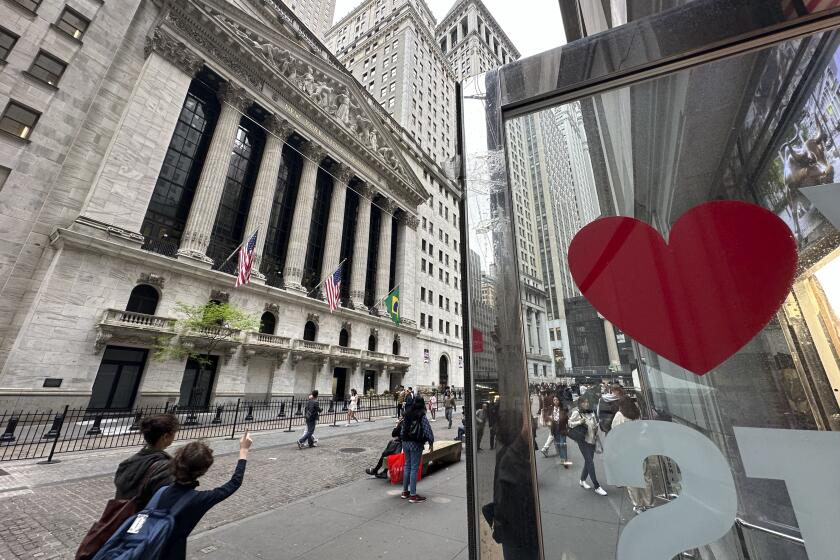FINANCIAL MARKETS : Jobless Report Sends Stocks, Bonds Falling
The stock market retreated Friday as a stronger-than-expected report on employment sent interest rates sharply higher.
The Dow Jones index of 30 industrials dropped 8.16 to 2,653.45, trimming its gain for the week to 18.21 points.
Declining issues outnumbered advances by about 4 to 3 in nationwide trading of New York Stock Exchange-listed stocks, with 642 up, 867 down and 492 unchanged.
Before the opening the Labor Department reported that the civilian unemployment rate dropped to 5.2% in July from 5.3% the month before.
Non-farm payroll employment increased by 169,000, on top of an upward-revised 250,000 gain in June.
The figures were interpreted as evidence of persistent strength in the economy, suggesting that the Federal Reserve might see little need to relax its credit policy further any time soon.
Although the news was a negative for interest rates, brokers said, it also helped to ease recent worries about a possible recession.
Thus, numerous stocks of companies in industries closely tied to the ups and downs of the business cycle, such as metals, chemicals and forest products, actually gained ground.
Phelps Dodge rose 2 3/4 to 69 7/8; Alcoa was up 7/8 to 71 1/2; Dow Chemical rose 1 1/4 to 93; Amax gained 1 5/8 to 26 1/2; International Paper rose 1 3/8 to 54 1/4, and Monsanto was up 1 1/4 to 117.
Walt Disney fell 4 7/8 to 116 1/8 in active trading after climbing 6 3/8 points Thursday. Some analysts expressed skepticism about recent takeover talk about the company.
Volume on the floor of the Big Board came to 169.75 million shares, against 168.69 million in the previous session. Nationwide, consolidated volume in NYSE-listed issues, including trades in those stocks on regional exchanges and in the over-the-counter market, totaled 201.56 million shares.
In Tokyo, the Nikkei index of 225 selected issues closed down 37.82 to 34,741.99. Trading was thin. “The main factor today is that institutional investors seem to have started their summer holidays,” said a trader for Kokusai Securities.
Stock prices in London surged in heavy trading, with the key British index closing at a new high for this year. The Financial Times-Stock Exchange 100-share index closed up 21.2 points, or 0.9%, at 2,327.5.
Credit
Bond prices took their biggest dive in about 22 months.
The yield of the Treasury’s benchmark 30-year bond rose above 8%, just a week after it finished the session below that level for the first time in more than two years.
The bond’s price fell 2 1/8 points, or more than $21 per $1,000 face amount, while its yield, which moves in the opposite direction from its price, leaped to 8.07% from 7.90% late Thursday.
The Shearson Lehman Hutton daily Treasury bond index, which measures price movements on all outstanding Treasury issues with maturities of a year or longer, dropped 12.67 to 1,188.13.
That was the biggest one-day decline in that index since it fell 13.08 on Oct. 14, 1987--five days before the stock market crash.
The trigger for the big price decline was the Labor Department’s report.
Elliott Platt, research director for Donaldson, Lufkin & Jenrette Securities, said the perception had been growing in recent days that the economy was slowing markedly and that the Federal Reserve may have to loosen its credit policy to avoid a recession.
But with the economy still expanding, he said, bond traders are now betting that the central bank will leave its policy unchanged for a while.
In the secondary market for Treasury bonds, prices of short-term governments fell 5/8 point to a full point, intermediate maturities lost 1 1/8 point to 1 1/2 points, and long-term issues fell as much as 2 1/8 points, according to Telerate Inc., a financial information service.
Yields on three-month Treasury bills rose to 8.11% as the discount jumped 22 basis points to 7.85%. Yields on six-month bills rose to 8.11% as the discount rose 27 basis points to 7.70%. Yields on one-year bills rose to 8.05% as the discount rose 33 basis points to 7.50%.
The federal funds rate, the interest on overnight loans between banks, traded at 8.875%, unchanged from late Thursday.
Currency
The dollar rose nearly 2% against major foreign currencies, its biggest gain in months. The selling binge in bonds set off by the Labor Department’s employment report drove interest yields higher and made the dollar-denominated securities more attractive to global investors.
Gold prices fell in U.S. trading after finishing higher overseas.
The dollar remained well below the peaks reached in June in spite of its one-day surge, which amounted to 1.9% against the West German mark, British pound and Japanese yen and an even 2% against the Swiss franc.
The higher yields on bonds and short-term securities attracted money into dollars, said Marc Cohen, a vice president at Republic National Bank of New York.
In Tokyo, the dollar closed at 138.05 yen, up 1.65 yen from Thursday. Later in London, the dollar was quoted at 139.40 yen. In New York, the dollar rose to 139.85 yen from 137.20 yen late Thursday.
In London, the dollar jumped against the British pound, with sterling falling to $1.6150 from $1.6475 late Thursday. In New York, the pound fell to $1.6060 from $1.6373.
Commodities
Gold and silver futures prices fell sharply Friday on New York’s Commodity Exchange as the dollar surged in value against other major currencies.
On other markets, the major agricultural commodities were higher and energy futures prices were mostly lower.
Gold futures settled $5.40 to $6 lower, with August at $367.80 an ounce; silver was 12.2 to 13.3 cents lower, with September at $5.20 an ounce.
The Labor Department’s revision of the June non-farm payroll number, showing a gain of 250,000 jobs instead of 180,000, indicated the economy was healthier than had previously been believed.
Soybean futures prices posted strong gains on the Chicago Board of Trade, rebounding from a weeklong string of losses as traders evened up their positions ahead of the weekend.
Grain futures also advanced, partly in tandem with soybeans and partly in reaction to a private crop-production estimate pegging the 1989 corn and soybean harvests slightly below Agriculture Department projections.
Soybeans for delivery in August had fallen a total of more than 85 cents a bushel in the five previous sessions as growing conditions improved and supplies of newly harvested South American soybeans increased.
“This rally was long overdue,” said Walter Spilka, grain-market analyst with Smith Barney, Harris Upham & Co. in New York. “The market was oversold technically and it was just a matter of which day it would fall on.”
Wheat settled 0.75 cent lower to 0.75 cent higher, with September at $3.8750 a bushel; corn was 1.50 to 2.50 cents higher, with September at $2.1950 a bushel; oats were 4 to 4.75 cents higher, with September at $1.4025 a bushel; soybeans were 6 to 16.50 cents higher, with August at $5.9075 a bushel.
Most live cattle futures climbed on buying spurred by strong cash markets. Higher cash hog prices supported the pork complex.
Crude oil futures sank on the New York Mercantile Exchange but the near-month contract failed to pierce $18 a barrel.
Tables begin on Page 5.






